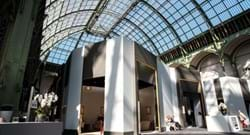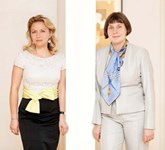“I want to put the collector at the very heart of the Biennale,” says Mathias Ary Jan. He took over last November as president of the Syndicat National des Antiquaires (SNA), the dealers’ association that organises France’s premier art and antiques fair, La Biennale, Paris.
Ary Jan, a dealer specialising in Orientalist painting who was formerly the SNA’s treasurer, is at 45 years old its youngest-ever president.
He has a big challenge on his hands, restructuring an art world institution and one that has been running every two years since 1956, turning it into an annual event in an already crowded fairs calendar.
This involves tempting overseas visitors to make the journey to Paris in a climate when many are less keen to travel to Europe. He also has to keep the Biennale’s roster of exhibitors happy.
ATG spoke to him on a visit to London to promote the Biennale, hot off the plane from a similar trip to New York.
Building blocks
“In a calendar where fair activity has greatly increased, we have to be able to offer major French and international collectors the finest pieces on the market every year,” Ary Jan says, summing up the task at hand. “That has led to setting up a new structure for the SNA on which we can build in years to come.”
Plenty has been going on behind the scenes, centred around the committees set up to run the fair.
One key development was the appointment last November of Christopher Forbes, vice-chairman of the eponymous publishing company, as chairman of the Biennale committee which selects the exhibitors, decides the décor and other practicalities.
“He is a marvellous ambassador, a well-informed Francophile, a major collector and a well-known American personality,” says Ary Jan.
Forbes played a key role in setting up the committee, chairing each meeting, paying particular attention to gallery selection as well as the creative direction of the 2017 show.
There are 15 committee members in total, six of them, including Ary Jan, from the SNA. The other members, such as Prince Amyn Aga Khan, Max Blumberg and Jacques Garcia, are active participants with opinions, says Ary Jan.
Forbes’ knowledge and contacts with American collectors and institutions (he is also president of the American Friends of the Louvre) is all-important. With TEFAF now staging fairs in New York, and the recent terrorist threats, the Biennale needs to tempt American collectors to leave their home turf.
Forbes was behind a summer trip to New York for meetings with collectors and museum curators and a breakfast with 15 arts journalists “to renew contacts and develop a desire to go to Paris in September and discover this new Biennale”.
“ These standards will make the Biennale the most rigorously vetted Salon in the world
Ary Jan says that “lots of ticket reservations” have been received, adding that, thanks also to the close relationship with the American Friends of the Louvre, he senses US collectors will attend.
He also feels the 30-strong honorary committee of international VIPs headed by his Highness Sheikh Hamada Bin Abdullah Al Thani will expand the fair’s reach.
What other measures are aimed at bringing footfall to the Biennale?
“We have placed high-profile ads in major international daily papers,” he says. “Hantang Culture, a major Chinese media group, is our partner to raise awareness with the Chinese collecting public and we are also working towards creating an attractive private tour package featuring events around the Biennale.”
As discussed in ATG No 2294, in order to “underscore the values of confidence and transparency”, the SNA has also strengthened the composition and role of the selection committee, making major changes to vetting and adding on-site laboratory facilities.
By removing itself from involvement in this committee and handing its running over to two external experts, the SNA is focusing on its independence and impartiality.
Ary Jan says: “We have set new standards in the works selection committee, a responsibility I delegated to two co-presidents: Frédéric Castaing et Michel Maket, respectively president of the National Company of Experts (CNE) and president of the French Syndicat of Professional Experts in works of art and collectables (SFEP).”
These independent committees, sub-divided by speciality and with restorers and museum professionals, had pre-vetting sessions of works until August.
“ Haute joaillerie must feel celebrated but so must the antique dealers
Ary Jan, as the president of the SNA, cannot intervene: “What is very important is that no exhibitor can be a member of the committees.” He adds that “the sum of these standards will make the Biennale the most rigorously vetted Salon in the world”.
He sees his role as ensuring that “exhibitors are happy about coming and participating in the Biennale and visitors and collectors are happy to come and have confidence. Both must feel reassured”.
The other major innovation, building on last year’s collaboration with the Hermitage, is the loan exhibition, discussed on page 23.
Design changes
The Biennale’s design is again by Nathalie Crinière, but the SNA has made a few practical changes. “We decided to close the Salon d’Honneur which posed difficulties to visitor flow last year and have concentrated the Biennale under the nave (the main ground floor of the Grand Palais).” The width of the aisles has been evened out for greater ease of movement.
And what of the exhibitor line-up this year, in particular the haute joaillerie that has long been a vital commercial plank of the event?
Last year’s show was marked by the absence of the major Parisian names in this field. While there are haute joaillerie exhibitors this year, such as Nirav Modi from Mumbai and Moussaieff from London, the big Parisian houses are not yet back.
How does the SNA plan to achieve a satisfactory mix of classic antique and branded jewels?
“Finding the right balance is our ultimate aim as haute joaillerie is part of the history and culture of the Biennale,” says Ary Jan. “Since my nomination as president I have been working toward this equilibrium but we have not quite managed to achieve the perfect harmony we wished for. This is mostly down to the timescales needed for creative work with the haute joaillerie houses.”
But he is confident that “Parisian haute joaillerie from the Place Vendôme” will be back for the 2018 edition. He is a fan and feels it must have its own section in the nave of the Grand Palais as it had in past years. “Haute joaillerie must feel celebrated, but so must the antique dealers.”
He points out that, as a change in the SNA’s statutes means that the president is now elected for three years at a time, he will manage a trio of Biennales. It’s something he believes brings stability and consensus.
Summing up, Ary Jan says he wants the Biennale week to be the artistic and cultural rentrée not only in Paris, but around Europe. “We are the first major event in the autumn calendar and we must capitalise on our particular status and make it a focus of attraction.”
Key changes to the Biennale’s works selection committee
■ Two expert co-presidents: Frédéric Castaing and Michel Maket, to guarantee the committee’s objectivity and independence.
■ Neither the president nor any elected representatives of the SNA can intervene in the decisions of the works selection committee.
■ The committee will not include any exhibitors among the consultants for the Biennale.
■ National and international restorers and institutions will be added to the committee consultants.
■ The establishment of an appeal for committee decisions is limited to three objects per exhibitor.
■ Only unique pieces, no series productions, and only works created before 2000 can be admitted.
■ The committee will have an on-site scientific system with analysis equipment at the Grand Palais.















